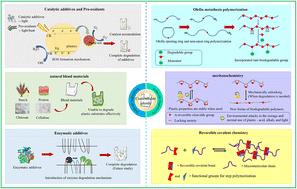在聚合物和分子水平上构建新型可降解塑料的实践和策略
IF 9.5
2区 材料科学
Q1 CHEMISTRY, PHYSICAL
引用次数: 0
摘要
塑料的方便和广泛使用造成了塑料垃圾的堆积,塑料垃圾具有缓慢降解的物理化学性质,对环境和人类健康构成严重威胁。为确保塑料的可持续使用,必须制定先进的减缓战略,以控制塑料的降解。鉴于此,本综述探讨了通过操纵其成分来诱导塑料有效降解所需的技术选择,特别是通过关注聚合物和分子水平上可用的方法。聚合物水平方法的可行性通过对各种添加剂(如光催化剂、促氧化剂、酶和天然聚合物)的效用进行比较分析来评估,而分子水平方法的可行性则在三种关键技术选项(即烯烃复分解聚合、机械化学和可逆共价化学)之间进行检查。虽然这些方法被用来帮助促进可降解塑料的设计和回收,但需要进一步的研究来克服许多技术限制(例如,意外降解,高成本和低机械强度)。本文还讨论了未来可控降解塑料生产的研究方向,包括采用数据密集型机器学习、多分子技术的结合以及降解产物的生态毒理学。本文通过在聚合物和分子水平上探索解决方案,对可降解塑料的规模化生产和降低其环境毒性所需的技术进行了全面概述。本文章由计算机程序翻译,如有差异,请以英文原文为准。

Practice and tactics in the construction of novel degradable plastics at polymer and molecular levels
The convenient and widespread use of plastics has caused a buildup of plastic waste with the slowly degradable physicochemical properties posing serious risks to the environment and human health. To ensure the sustainable use of plastics, it is important to develop advanced mitigation strategies for their controlled degradation. In light of this, this review explores technical options required to induce the efficient degradation of plastics through the manipulation of their composition, especially by focusing on the approaches available at polymer and molecular levels. The feasibility of the polymer-level approach is evaluated through comparative analysis of the utility of various additives (e.g., photocatalysts, pro-oxidants, enzymes, and natural polymers), while that of the molecular-level approach is examined between three key technical options (i.e., olefin metathesis polymerization, mechanochemistry, and reversible covalent chemistry). Although these approaches are employed to help facilitate the design and recycling of degradable plastics, further research is needed to overcome many technical limitations (e.g., accidental degradation, high cost, and low mechanical strength). Future research directions for the production of controlled degradable plastics are also discussed in relation to advanced options such as adoption of data-intensive machine learning, combination of multimolecular techniques, and the ecotoxicology of their degradation products. This review offers a comprehensive overview of technologies needed for the scalable production of degradable plastics and the reduction of their environmental toxicity by exploring solutions at both the polymer and molecular levels.
求助全文
通过发布文献求助,成功后即可免费获取论文全文。
去求助
来源期刊

Journal of Materials Chemistry A
CHEMISTRY, PHYSICAL-ENERGY & FUELS
CiteScore
19.50
自引率
5.00%
发文量
1892
审稿时长
1.5 months
期刊介绍:
The Journal of Materials Chemistry A, B & C covers a wide range of high-quality studies in the field of materials chemistry, with each section focusing on specific applications of the materials studied. Journal of Materials Chemistry A emphasizes applications in energy and sustainability, including topics such as artificial photosynthesis, batteries, and fuel cells. Journal of Materials Chemistry B focuses on applications in biology and medicine, while Journal of Materials Chemistry C covers applications in optical, magnetic, and electronic devices. Example topic areas within the scope of Journal of Materials Chemistry A include catalysis, green/sustainable materials, sensors, and water treatment, among others.
 求助内容:
求助内容: 应助结果提醒方式:
应助结果提醒方式:


